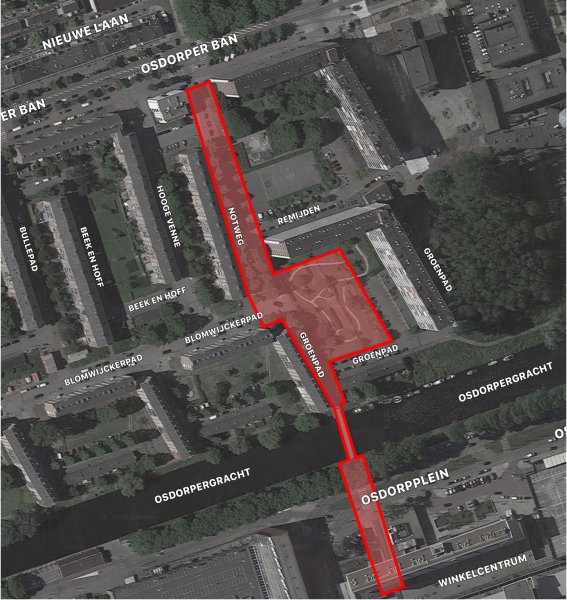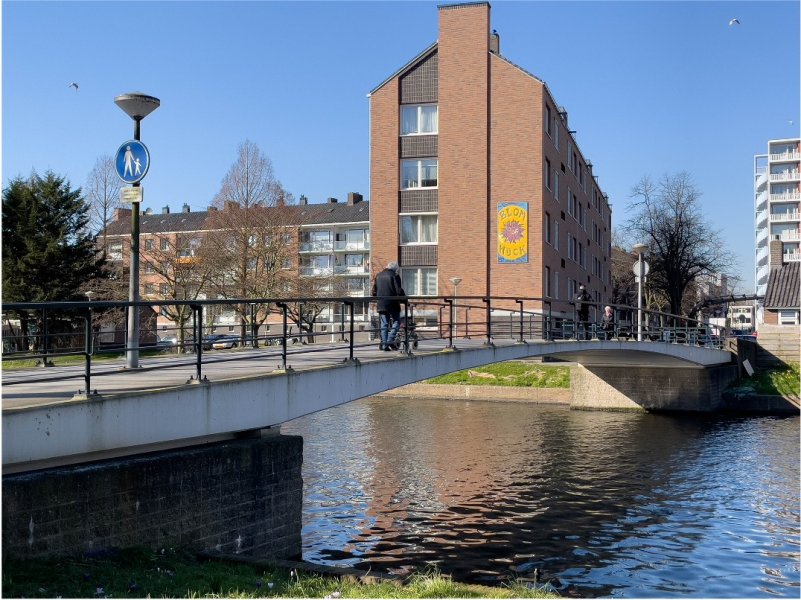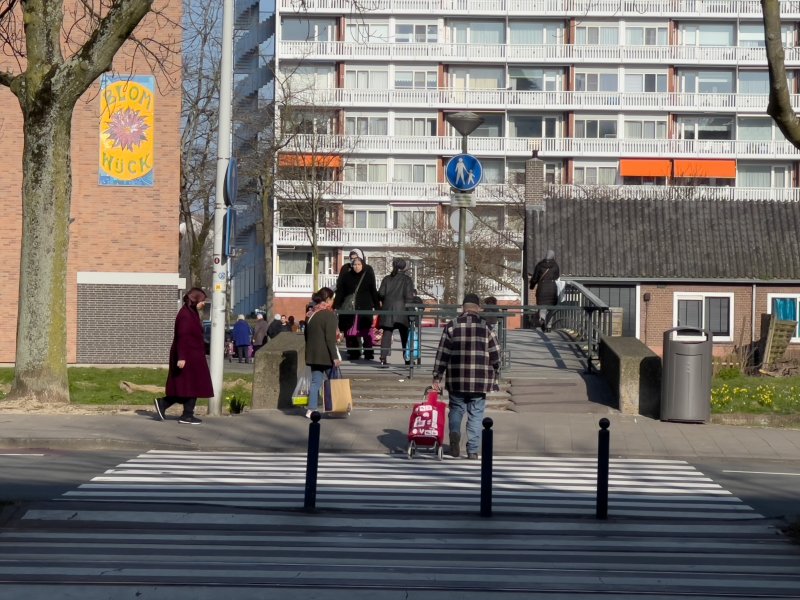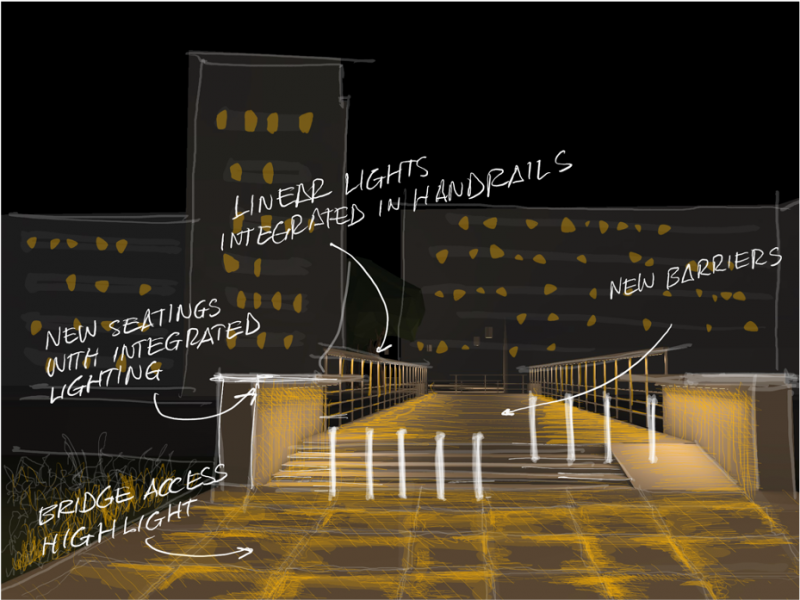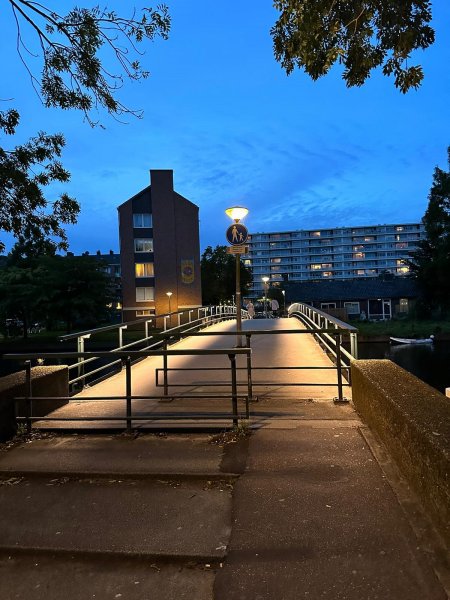
Selected district
Wildeman, Nieuw-West
Intervention site
The pedestrian bridge over the Osdorpergracht
- About the district
With a population of 160,124 inhabitants, Nieuw-West is a modernist post-war development constructed on the principle of garden cities. It consists of 5-9 storey apartment blocks surrounded by green spaces with active commercial and business use. As part of the extension of Amsterdam to the west, including land reclamation involved in the building of Schiphol airport, the district name literally means ‘new West’ and lies about 9.5 km from the city centre.
The intervention site is situated in the sub-district of Wildeman, a low income and multi-ethnic neighbourhood with a population of around 5,000, 19% of whom are over 65. At the heart of Wildeman are several large apartment blocks specifically designated for the over-55s. While the majority of the elderly are ethnic Dutch, the neighbourhood itself has mostly immigrant populations, largely Turkish and Moroccan who original came as guestworkers, and immigrants from former Dutch colonies such as Indonesia and Surinam. More recently, there have been high levels of middle class in-migration, including young families, young professionals and students. This makes for a neighbourhood of considerable complexity which is the target of a wide range of state interventions, development plans and programmes, as well as high levels of community organisation.
As a site for ULLs and lighting interventions, Wildeman presents the prospect of studying multiple and ethnically distinct patterns of ageing in relation to light and wellbeing.
- About the intervention site
The challenge for selecting an intervention site in Wildeman was the high level of existing and ongoing redevelopment activity. The most suitable site is a pedestrian bridge that connects residential areas of Wildeman with the main commercial district of Osdorpplein by crossing the Osdorpergracht, a local water canal. This bridge is universally recognised by residents and visitors, is used on a routine, even daily, basis by all active citizens and is, in terms of material fabric, regarded as unloved, dirty, unaesthetic, merely functional. The wheelchair ramps on both sides of the bridge are likewise untidy. From a social perspective, the bridge is important as it connects the Wildeman neighbourhood with a major pedestrianised shopping area, frequented by older citizens. Station Wildeman is the ULL community base and it is also undergoing redevelopment and has entered into discussions as to how to incorporate ENLIGHTENme findings into their lighting and public realm strategy.
In terms of a lighting intervention, the bridge and adjacent areas are due for an upgrade and many areas fall under various redevelopment programmes. The lighting in general comprises very poor legacy technology, from fluorescent to poor colour rendering LED retrofit lamps. The lighting levels are also very low and generally obstructed by tree foliage. Wayfinding and orientation are poor, and the area is difficult to navigate in the dark. The elderly have major visibility issues and the high lighting contrast and great darkness of the area do not support elderly citizens' mobility. The bridge is the heart of the area. The lighting system on the bridge and the surrounding area is not adequate for wayfinding, multi-user presence or mobility vehicles. There are several dark spots on both ends and in the middle of the deck. The lighting poles are not adequate to properly light the bridge.
- Local structure and culture of ageing
- There is an extremely high level of civil society activity and organisation, and a strong culture of volunteer activity.
- Strong opportunities for networking with community groups.
- Social isolation of the elderly is a factor and ULL activities, including research, have needed to focus on understanding the elderly through younger generations and family networks rather than directly; and seeking access through home visits rather than ULL events.
- The new lighting and installation design
The new design aims to provide uniform and continuous lighting along the entire extension of the bridge. Linear tunable white LEDs will be integrated and hidden in the handrail capable of providing adequate lighting for citizens and making the bridge itself a landmark element in the nocturnal context of the neighbourhood.
At the two landings of the bridge, seating is provided near the ramps and stairs leading to the bridge. The lighting in these areas is in continuity with the bridge. The linear LED of the handrails continues to integrate into the wooden seats and creates a welcoming area for those crossing the bridge. On the shopping centre side, spotlights attached to the tree branches on the bridge are also planned. This choice, in addition to increasing the lighting levels at the pedestrian crossing, is useful for giving the area a particular character. Lastly, still in correspondence with the pedestrian crossing, the introduction of a street pole on the sidewalk on the side of the shopping centre is envisaged, capable of increasing the illuminance values and guaranteeing visibility to pedestrians crossing the street since the street lighting system existing at this point is ineffective, inadequate and obstructed by vegetation.
ULL activites
Timeline
03 March 2022
Projects Fair
Networking event at Station Wildeman
23 June 2022
Networking Event
Stakeholder meeting to present ENLIGHTENme aims and coordinate activities.
23 June 2022
Public Meeting
Presentation of ENLIGHTENme aims and activities as well as public lighting installation plans.
24 June 2022
Workshop
Introduction of ENLIGHTENme and ULL project. Focus on ageing issues and importance of lighting. Virtual nightwalk around Wildeman.
01 June 2022
Night walk with city team
One-hour-long walk along lighting installation site to familiarise project partners and networks with project methodology and aims and to get detailed understandings of specific features of the installation site.
20 October 2023
Launch of new lighting installation
Community launch of the newly installed lighting introducing local residents to the installation and its smart lighting control programmes.




